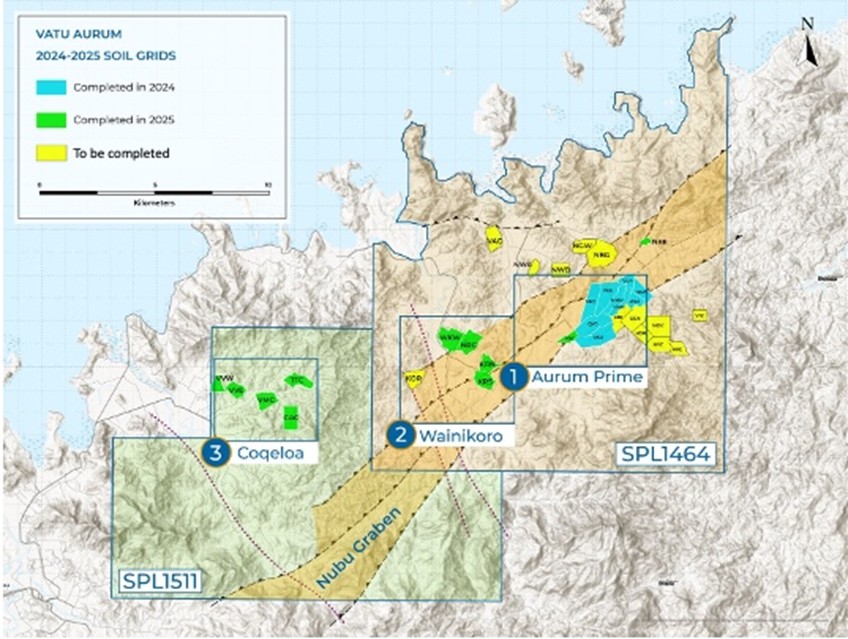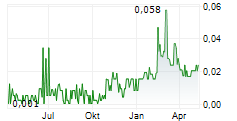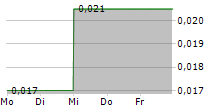VANCOUVER, BC / ACCESS Newswire / October 1, 2025 / Kalo Gold Corp. (TSXV:KALO) ("Kalo" or the "Company") announces completion of the first phase of drilling and the continuation of field programs at its 100%-owned 367 km² Vatu Aurum Project, Fiji. Phase 1 tested an initial subset of the more than 25 high-priority targets defined across the Aurum Epithermal Field, which hosts both vein-hosted and diatreme/surge-related epithermal gold. Assays are pending, with initial results expected in mid-October 2025.
Key Takeaways
Vatu Aurum hosts two complementary gold systems: epithermal gold target corridors (Namalau, Loma, Buca) and volcanic breccias (diatremes) at Qiriyaga - styles that in similar Pacific Rim deposits have supported both high-grade and bulk-tonnage gold mineralization (no economic comparison is implied).
Phase 1 drilling tested only 4 of 25+ defined targets, meaning the majority of the Aurum Epithermal Field remains untested.
The geology indicates the Namalau Trend is interpreted to be a well preserved epithermal system, while at the Qiriyaga Complex, where several historical resource estimates and more than a dozen newly identified diatremes highlight potential for both shallow and deeper gold mineralization (*see Historical Estimate Disclaimer).
Assays expected mid-October will provide the first test of gold tenor and continuity, guiding follow-up drilling.
Two Distinct Mineralization Styles at Aurum Prime
Phase 1 drilling, trenching, and mapping have provided important geological context, supporting the interpretation that Aurum Prime hosts two distinct mineralization styles.
Epithermal Vein-Hosted Systems - Namalau, Loma & Buca Trends
Structurally controlled quartz veins and hydrothermal breccias - essentially fracture zones where gold-bearing fluids deposited quartz and breccia bodies.
Pathfinder anomalies (Se, As, Sb, Hg, Tl) are consistent with a fertile low-sulphidation epithermal system.
Preservation of surface sinters, bladed quartz, and silica flooding indicates limited erosion and supports the interpretation of a vertically intact epithermal profile.
Geological features are consistent with vein systems such as the Martha Mine in Waihi, New Zealand, where narrow veins observed at surface were later shown to connect into broader mineralized zones at depth, though no resource or economic comparison is implied.
Diatreme/Surge Systems - Qiriyaga Complex
Reinterpreted as a preserved diatreme system with an epithermal overprint - essentially a volcanic vent filled with explosive breccias that were later mineralized by gold-bearing fluids.
Mineralization occurs both in the breccia matrices and in pyroclastic surge horizons around the vent.
Earlier work defined five diatreme centers (QC1-QC5); mapping now identifies more than a dozen centers, the majority of which remain untested.
Historical drilling and multiple past resource estimates demonstrated both broad zones and localized high-grade shoots. Reinterpretation suggests earlier work only sampled the shallow preserved portion of a system that is both vertically and laterally extensive (*see Historical Estimate Disclaimer below).
For geological context, features are consistent with preserved maar-diatreme systems such as Kelian (Indonesia) and Balatoc (Philippines), which demonstrate how preserved maar-diatreme settings can host both bulk-tonnage breccia gold and structurally focused high-grade mineralization, though no resource or economic comparison is implied.
Together, these styles reinforce that Vatu Aurum is a large system with multiple mineralization pathways preserved and only a fraction tested to date.
"Our exploration to date supports the interpretation of two mineralization styles at Vatu Aurum - vein-hosted systems at Namalau, Loma, and Buca Trends, and diatreme/surge-related mineralization at the Qiriyaga Complex. The Namalau Trend is interpreted to be a well-preserved epithermal system, while Qiriyaga builds on several historical resource estimates and newly identified diatremes that remain largely unexplored. Together, these reinforce our view that we are advancing a vertically intact, large-scale system. With assays pending and additional drilling planned, we are well-positioned to create meaningful value for our shareholders." - Terry L. Tucker, P.Geo., President & CEO.
Exploration Progress
The 2025 exploration program continues to advance systematically across multiple targets within the 367 km² Vatu Aurum Project. Field operations have been executed safely and efficiently, with zero lost-time incidents (LTIs) recorded year-to-date. Completed work includes:
Activity | Completed to Date | Notes |
|---|---|---|
Diamond Drilling | 2,436.7 m (11 holes) | Focused on Dua and Rua epithermal upwelling zones in the Namalau Trend and QC1 and QC3 in the Qiriyaga Complex (Figure 1) |
Trenching | 2,453 m (21 trenches) | Testing surface anomalies at Namalau, Buca, and Loma Trends, Qiriyaga Complex and Vunikulukulu (Figure 1) |
Soil Sampling | 14,573 samples | Coverage across Aurum Prime, Wainikoro, and Coqeloa (Figure 2) |
Next Steps
Report pending assays from Phase 1 drilling, with initial results expected in mid-October.
Report Aurum Prime trench results.
Report Wainikoro, Coqeloa and Aurum Prime soil results.
Step out at Namalau Trend to drill test feeder structures at depth and along strike, while expanding into the untested corridors at Loma and Buca Trends.
Advance Qiriyaga Complex testing with additional drilling of breccia-hosted targets guided by the new diatreme framework.
Expand systematic testing of the 25+ high-priority targets, the majority of which remain untested, supported by trenching and mapping to bring additional zones to drill-ready stage.
Deploy a Portable PPB detectORE unit to generate near real-time gold data, accelerating targeting decisions and reducing reliance on external assay turnaround.
Integrate multi-dataset vectoring (soils, trenches, TerraSpec, XRF, ICP, geophysics and geological relogging) to refine structural controls and prioritize feeder zones.
Together, these geological observations and the work completed to date position Kalo to advance from initial testing toward unlocking the broader district potential.
Exploration activities remain on schedule and aligned with the 2025 strategy, with Phase 1 drilling and trenching providing valuable geological context. Results to date support the interpretation of a vertically preserved epithermal system at Aurum Prime, alongside diatreme-related mineralization at the Qiriyaga Complex. Together, these observations reinforce the scale potential of Vatu Aurum as a multi-corridor, multi-target district.
Initial assays, expected in early to mid-October, will provide the first opportunity to evaluate gold tenor and continuity across feeder zones and breccia targets. Follow-up drilling is anticipated to test deeper structures and expand mineralization along the Namalau Trend and within the Qiriyaga Complex.
With assays pending, field verification ongoing, and vectoring continuing, Kalo is well positioned to advance its most prospective targets into the next phase of drilling. With more than 25 identified targets and only a fraction drill-tested, the current program represents just the beginning of unlocking the full scale of the Aurum Epithermal Field.
Qualified Person
The technical information in this news release was prepared, reviewed, and approved by Andrew Randell, P. Geo, principal of SGDS Hive, a qualified person as defined by National Instrument 43-101 of the Canadian Securities Administrators. Mr. Randell is independent of the Company and has verified the data disclosed having conducted multiple site visits, directly supervises the exploration program, completed review of field data collection protocols, including sampling procedures, analytical methods, and quality assurance/quality control protocols, where applicable.
About Kalo Gold Corp.
Kalo Gold Corp. (TSXV:KALO) is a gold exploration company focused on low-sulphidation epithermal gold systems in Fiji. The 100%-owned Vatu Aurum Project spans 367 km² on Vanua Levu, located in a preserved volcanic-back arc setting with district-scale gold potential. Exploration is centered on the Aurum Epithermal Field, where drilling, trenching, and geochemistry have outlined multiple structurally controlled gold targets. Kalo's technical programs are led by SGDS Hive.
On behalf of the Board of Directors of Kalo Gold Corp.
Terry L. Tucker, P.Geo
President and Chief Executive Officer and
Kevin Ma, CPA, CA
Executive Vice President, Capital Markets and Director
For more information contact, please write to info@kalogoldcorp.com
Neither the TSX Venture Exchange nor its Regulation Services Provider (as that term is defined in the policies of the Exchange) accepts responsibility for the adequacy or accuracy of this press release.
Forward-Looking Statements Disclaimer
This news release contains "forward-looking statements" within the meaning of applicable securities laws. These statements reflect management's current expectations, strategic objectives, and exploration priorities at the time of this release. Forward-looking statements are not statements of historical fact and include, but are not limited to:
The Company's planned multi-phase exploration and drilling program, including the targeting of structurally controlled gold zones at Coqeloa, Aurum Prime, Namalau, Loma, Buca Trends, and the Qiriyaga Complex.
Interpretations of geological features, mineralization continuity, and deposit potential, based on geophysical surveys, surface sampling, and historical drill data, which are subject to change as additional drilling and verification work is conducted.
The potential for district-scale gold mineralization, subject to further exploration, drilling, and independent verification.
All exploration results, including geochemical data and historical intercepts, are preliminary in nature and do not constitute a mineral resource estimate. Further exploration, including drilling, is required to confirm the continuity, grade, and extent of mineralization at the Vatu Aurum Project.
The Company's ability to secure sufficient financing, obtain necessary regulatory approvals, and establish strategic partnerships to advance exploration and development activities.
Exploration Risks & Uncertainties
Forward-looking statements are subject to geological, financial, and regulatory risks that may cause actual results to differ materially from those anticipated. These risks include, but are not limited to:
Exploration risk: There is no guarantee that current exploration activities will result in an economically viable mineral resource.
Drilling uncertainty: Trench and soil sampling results are not necessarily indicative of subsurface mineralization, and drilling is required to confirm continuity, grade, and extent.
Permit and regulatory risks: Exploration activities are subject to government approvals, environmental regulations, and permitting requirements.
Funding constraints: The Company's ability to execute exploration programs depends on market conditions and financing availability.
Commodity price volatility: Gold price fluctuations may impact the economic feasibility of any future discoveries.
Forward-looking statements contained in this news release are based on current expectations, estimates, forecasts, and projections about Kalo Gold Corp.'s business, as well as beliefs and assumptions made by the Company's management.
Readers are cautioned that forward-looking statements are based on assumptions that may not prove to be correct. Actual results may differ materially due to several known and unknown risks and uncertainties that are beyond the control of the Company.
Kalo Gold Corp. does not undertake any obligation to update or revise any forward-looking statements, except as required by applicable securities laws. Readers should not place undue reliance on forward-looking information contained in this release.
For a more detailed discussion of risks and uncertainties, please refer to Kalo Gold Corp.'s public filings on SEDAR+ at www.sedarplus.ca.

Figure 1. Aurum Prime: Aurum Epithermal Field target map. The 26 February 2025 news release outlined more than 25 high-priority targets across the Namalau and Loma-Buca Trends and the Qiriyaga Complex. Targets include both epithermal upwelling zones and diatreme/maar-related breccia systems (for illustrative purposes only).

Figure 2 - Aurum Prime, Wainikoro and Coqeloa soil grids (for illustrative purposes only).
*Historical Estimate Disclaimer
The Qiriyaga Complex (Qiriyaga Hill and Vuinubu Ridge Gold Deposits) have been the subject of several historical mineral resource estimates completed between 1991 and 2017. These estimates are considered historical in nature and do not conform to current CIM Definition Standards or NI 43-101 reporting requirements. A Qualified Person has not done sufficient work to classify these historical estimates as current mineral resources, and Kalo Gold is not treating them as current resources. Additional drilling and technical studies would be required to verify and update any historical estimate.
** Comparison with Kelian and Balatoc
Analogue Context: Diatreme-Epithermal Gold Systems
For geological context, the Qiriyaga Complex shares key geological features with other diatreme-epithermal gold systems in the Pacific Rim, most notably the Kelian Deposit in Indonesia and the Balatoc Diatreme in the Philippines.
At Kelian (East Kalimantan, Indonesia), mineralization was hosted within maar-diatreme breccias and hydrothermal breccias. Before mining commenced, Kelian contained reserves of ~55 Mt at an average grade of 3.2 g/t Au, including localized high-grade zones >10 g/t Au. Between 1992 and 2004, the operation produced ~5.75 Moz of gold and ~4.66 Moz of silver. Mineralized breccias extended to depths of >600 m, with gold occurring both as broad zones of disseminated breccia-hosted mineralization (typically 1-2 g/t Au) and as structurally focused high-grade shoots localized along breccia contacts and splays.
At Balatoc (part of the Acupan system, Baguio District, Philippines), historical records indicate that Acupan as a whole produced more than 6.4 Moz of gold at an average grade of ~6 g/t Au. Within the Balatoc diatreme itself, past estimates outlined 2.5-4.0 Mt at ~3.8 g/t Au cut-off, with reported grades ranging from 4-30 g/t Au in vein zones and up to 12.6 g/t Au in breccia-hosted bodies.
While Qiriyaga is still at an early stage and no mineral resources have been defined, these analogues demonstrate how preserved maar-diatreme systems can host multimillion-ounce gold deposits, with a combination of bulk-tonnage breccia mineralization and structurally focused high-grade zones. This provides valuable geological context and underscores the scale potential of the Qiriyaga Complex within the Aurum Epithermal Field.
Cautionary Note on Analogues
The Kelian and Balatoc deposits are referenced strictly for geological context and exploration targeting purposes. The production figures, grades, and tonnages cited are historical in nature and are not intended to imply that similar results will be realized at the Vatu Aurum Project. The Qiriyaga Complex is at an early stage of exploration and no mineral resources or reserves have been defined under NI 43-101. Further drilling, sampling, and technical studies are required to determine the presence of any mineral resources at Qiriyaga.
SOURCE: Kalo Gold Corp.
View the original press release on ACCESS Newswire:
https://www.accessnewswire.com/newsroom/en/metals-and-mining/kalo-gold-completes-first-phase-drilling-and-continues-field-program-at-vatu-auru-1080342


